
 |
Didactic Unit: Visit to the Archipelago of Cabrera |
| In Spanish (Castellano), In Catalan |
By
Margalida González,
Miguel Rayó,
Ma del Pilar Gassó, Palma de
Mallorca, SPAIN, 1998
English translation of the
Spanish original.
Contribution to the
EDUVINET "Global Challenge"
subject
Every year at the end of the course we visit Cabrera.
The pedagogic interest of Cabrera is very large, because the archipelago is like a natural laboratory: given its small size and the simplicity of its ecosystems it is relatively easy to study the mechanisms of the evolution and of the basic concepts of ecology. At the same time we will be able to know which have been the human utilizations of the archipelago of Cabrera in the course of the time and how it has gone from the purely utilitarian uses to those of the conservation of the natural area.
It also allows us to check the fundamental concepts of the curriculum of Sciences of Nature in Fourth course of ESO and, at the same time, to put into practice those attitudes we have tried so much to encourage in the study of Ecology (Cross-Curricular Themes), especially in those that concern the conservation of natural species and areas.
(In the classroom)
(In the visit to the natural area)
Situation and geography of the Archipelago
The archipelago of Cabrera is located in the Western Mediterranean Sea, in the south of Mallorca island, the largest of Balearic Islands, between 2º 54' 26"E and 2º 59' 18" E and 39º 07' 06"N and 39º 13' 03"N. It consists of a principal island called Cabrera and 18 smaller islands.

Island concept
Islands are lands surrounded by the sea. A careful analysis of this known definition permits us to observe that it is not exact enough, since it would also be the definition of a continent. This is the reason why we should add a variable, extent. Taking into account the extent of the land space surrounded by the sea we will be able to distinguish among continents, islands, islets, reefs.....
The archipelago extent is of 13,22 Kms2 and that of Cabrera island is of 11,55 Km2.Apart from Conills island, the others are small islands, some of them practically inaccessible.
How Cabrera archipelago has been formed
The islands have different origins : some of them have a volcanic origin, others are coral, others are small pieces of continents that water has broken when the sea deluged valleys and plains that were joined to the land. The islands of Cabrera archipelago as most of mediterranean islands, belong to the third group.
The relief of the archipelago has not alwaysbeen as we know it at present, but it is the result of a series of complex geological phenomena that have been working during million of years.
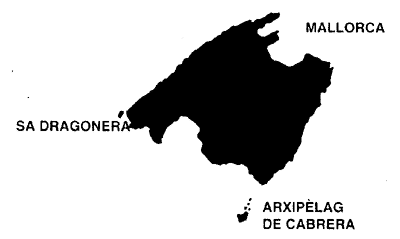
In the Jurassic age, about 200 million of years ago (m.a.), the Mediterranean Sea was a great ocean called Sea of Tehys, and what today we know as Cabrera was the bottom of the sea, where sediments and remains of animals and marine plants were deposited. Therefore, it is so frequent to find there fossils of marine organisms. All these sediments got compact and produced stratified calcareous rocks.
By the end of the Oligocene age, the movement of the European and African plates folded and lifted these rocks, originating the great Andalusian mountain chain, from which Cabrera and Mallorca were forming part.
In the Pliocene, the last period of the Terciary era, the islands were separated from the Iberian peninsula.
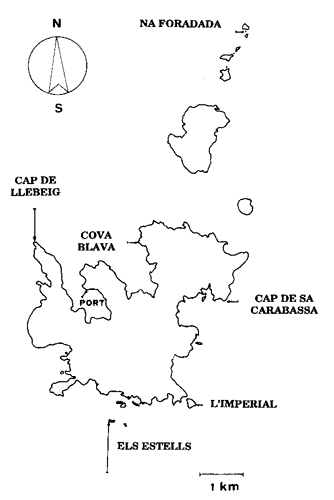
In the Quaternary era, the climate has suffered sharp changes causing strong variations of the sea level. Glacial periods caused the freezing of large masses of water, which were accumulated in the form of ice, touching the poles and on the large mountain chains. The level of the Mediterranean decreased more than 100 ms and thus, Cabrera remained joined to Mallorca and Menorca.
After the last glacial period, ice melted, the Mediterranean was recovering its level and, about 12.000 years ago, Cabrera remained definitely separated of Mallorca.
About geology
The island of Cabrera is a southern continuation of the mountains of Eastern Mallorca. Its coast offers some outcrops of great quality that provide optimum conditions for the study of geology. Many geological phenomena are very obvious in Cabrera where anticlinals, synclinals, defects, etc. can be seen.
The most ancient materials are from the Secondary Era but we can also find others from the Terciary Era full of nummulits (some of the most abundant fossils), and also from the Quaternary Era.
Cabrera presents an extremely cut out coast deepening among calcareous reliefs. Between the two most important crest lines (which present heights of more than 100 ms) there is the entry of the port where we will disembark. It is the most protected shelter of the archipelago.
During thousands of years rainwater has been dissolving the calcareous rock in a chemical process - karstification - which results in the formation of caves, hollows, ledges , etc.
Besides, the action of the waves on the coastal undermines the cliffs and causes the coast modeling, forming archs, caves, small hollows.
The environmental conditions and the limitation of space in Cabrera archipelago determines that their living beings communities show the following characteristics.
The vegetables
The lack of rainfalls and the poverty of soils determine a form of vegetation adapted to endure the summer aridity.
Trees
The only present tree in the archipelago is the pine. (Pinus halepensis). It is considered as a pine of strictly Mediterranean distribution and it is probably the most abundant tree in the Balearic Islands.
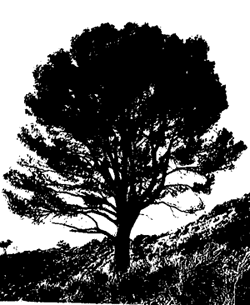
When environmental conditions are suitable, it grows up to 20 ms high, but in very windy places it does not go over two metres.
The pinecones, of a conical shape, are smaller than those from other pines.
The leaves are aciculate, of clear green color, of about 6 cms long and they are grouped in two by two.
The pinegroves covering a third of the surface of the largest island, Cabrera, are located in the north , but they are also found in small groups everywhere .
Shrubs
The dominant vegetation in Cabrera is the scrub(garriga).
In the scrub we find abundant shrub-like species adapted to living on a poor soil and to endure the summer aridity.
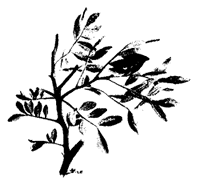
Most of these plants are green during all year and their leaves are hard and small (coriaceous). These characteristics make the plant reduce its perspiration , that is , the loss of water by evaporation of the leaves. This is a common characteristic among the plants of the Mediterranean region.
The most important examples of this kind of plants are the lentisc scrub (Pistacia lentiscus) and the wild olive tree (Olea europaea).
We can also find other kinds of smaller shrubs with their aciculate leaves; as a rule they are aromatic plants, laden with essences. In this group we can mention the heather (Erica multifora) and the rosemary (Rosmarinus officinalis).
Other plants
Among the large number of plants present in the archipelago, and not included in the two previous mentioned groups, we can underline the "rapa pudenta" (Dracunculus muscivorus) because of its characteristics.
This plant is a Tyrrhenian endemism, that is, it only grows in some Mediterranean islands, such as: Corsica, Sardenia and the Balearic Islands.
It belongs to the Arum family. It is very bright and colourful; in April it forms a large inflorescence in the shape of a purple with dark marks funnel. Its flowers, feminine and masculine, are placed around a rod or spadix, so that the feminine flowers remain in the base and the masculine ones a little higher.
Their pollination is a good example of mutualism.
Masculine and feminine flowers ripen at different times to avoid self-pollination. When feminine flowers get fertile they give off a strong fetid odor attracting flies.. The insects enter the funnel, carrying polen from other flowers but they cannot leave for two or three days when feminine flowers have withered and the masculine ones, which during this time have become fertile, have filled them with their polen.
Animals
The limitation of the space and, therefore, of the resources, together with the relatively adverse climatology make the number of animal species present in the archipelago be reduced.
With respect to the mentioned vertebrates, we only find three species of reptiles. Mammals are represented by nine kinds. Only three of bats can be considered autochthonous. The rest of the species, from the genet to the rabbit, have been introduced by man.
The amphibians are perhaps the very absent (certainly due to the lack of permanent water accumulations).
Reptiles:
Lizard (Tarentola mauritanica)
Small lizard (Hemidactylus turcicus)
Wall lizard (Podarcis lilfordi)
Mammals:
Genet (Genetta genetta)
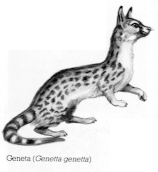
Hedgehog (Atelerix algirus)

Rabbit (Oryctolagus cuniculus)
Rat (Rattus rattus)
Mouse (Mus musculus )
Cat (Felis silvestris)
Birds are the group of vertebrates that presents a greater diversity since, as it is obvious, the sea does not suppose a barrier that separate them definitely from the continent or from the bigger islands, as it happens to most of the other animals.
Concerning the marine and certain rapacious birds, some of them in danger of extinction, the natural park represents a quiet area, away from men, suitable for nest-building.
Among the sea birds, the most threatened species, in danger of extinction, is the corsican gull (Larus audouinii). This is an endemic bird from the Mediterranean and has in Cabrera one of the principal areas for breeding.
Other species present in the archipelago are:
Storm Petrel (Hydrobates pelagicus)
Balearic Shearwater (Puffinus yelkouan mauretanicus)
Cory's Shearwater (Calonectris diomedea)
Shag (Phalacrocorax aristotelis)
Herring Gull (Larus cachinnans)
Rapacious birds are also well represented, such as: Osprey (Pandion haliaetus), Eleanora's Falcon (Falco eleonorae), Peregrine (Falco peregrinus). They are threatened species that raise between the cliffs.

Lizards
The almost absence of predators in the archipelago implies that some species develop better than in other places. This is the case of the wall lizard that was extinguished in the larger islands, Mallorca and Menorca, with the arrival of man, but it has survived without problems in all the islands and islets of Cabrera.
The wall lizards of the archipelago belong to Podarcis lilfordi species. They are of a rather modest size, 14 cms from head to tail in males of the largest species (about 8 cms from head to cloaca ). Their scales are very fine and abundant. Their colour is very variable, from earthy green to dark blue, almost black. Their abdomen is whitish, orange or blue, with some dark marks on their throat.

Wall lizards are an extraordinary example of adaptation to their habitat. Only in the archipelago of Cabrera we can find 11 subspecies that are distinguished some from others by small variations in their form and colour. It is believed that these differences are the result of natural selection and genetic isolation they have been subjected for, at least, 6.000 years ago.
The case of Cabrera: from the talayotic remains to the conservation of nature.
The Mediterranean islands, by the fact of being located in a closed sea, have always been used as a point of reference for navigators, who used them as a shelter in storm days, as a source of water or food provision, or as a place of settling and colonization.
The Mediterranean islands have been the object of these uses from prehistoric times. Thus, in Cabrera there are very ancient talayotic remains, which show the temporal presence of human beings there. Besides, archeologists have found shipwreck remains in the seafloors of Cabrera, ships that were transporting wine, oil and grain amphoras, by the coasts of the clasical Greek and Roman Mediterranean Sea.
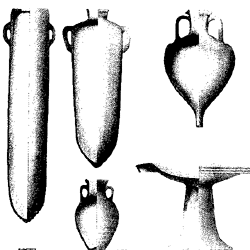
It seems to be that, in the first centuries of the Middle Ages, there was a religious settling in the island and, during all the era, the port of Cabrera, which is an excellent shelter for ships, was visited by merchants, pirates, fishermen and sailors. In fact, the castle of Cabrera was built in the XIV century to prevent the berber pirates being able to use the port as a refuge, before and after their raids along the coast of the neighbouring island of Mallorca. By the end of the last century the present lighthouses were built. While there were inhabitants there - up to the second half of the XX century - they grew cereals, raised sheep, pigs and , above all, goats, nowadays removed. It is possible that the island name has to do with the abundance of this last mammal. Still today, the fishermen seek refuge from storms, and a place to rest and to sew and repair their nets.
But the most notable historical event in Cabrera was the confinement in the island of thousands of French prisoners, soldiers from the Napoleonic army defeated in the battle of Bailén, at the turn of the XIX century. These men's imprisonment was a real tragedy. A simple stone monument recalls the event. By the end of the last century and the turn of this one, Cabrera was a smugglers hideout and even, an agricultural community wanted to settle there, with a stable population. The community failed. Afterwards, during the I World War , the island was occupied by the Spanish army,which even used Cabrera and the rest of its islands as a place to carry out maneuvers and military exercises.
Lately and for about twenty years, naturalists and protectionists studied the islets flora and fauna, and came to the conclusion that the natural values of the area, its fauna - the wall lizards, the sea birds, the hawks - and its, land as well as marine, flora- with some outstanding endemisms- needed to be preserved forever .
Nowadays Cabrera is a National Park; this means that the natural area included among the limits of the park remain protected from improper human uses. Some guards - men and women -watch visitors of the island do not injure natural elements of the place; where you can only carry out research and environmental education activities and naturalist tourism. A museum installed in one of the old agricultural houses of Cabrera allows thevisitor to know the history of the islands human uses, and also the natural values they keep.

Initial and search of information activities
* Regarding to what we have been able to work about in the previous parts of the unit ( geological history and the islands formation, climatic conditions, natural systems, flora and fauna species, etc.) the pupils will try to establish, through a debate in the classroom, what have been the possible uses men have made or can find in small Mediterranean islands.
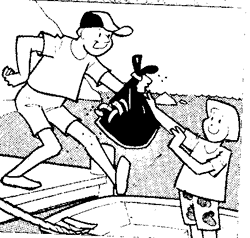
We give below an exhaustive list of activities to carry out before, during or after the visit.
(In the visit to the natural area)
Criteria and evaluation activities
The evaluation of this part of the unit will be accomplished , above all, in a qualitative way in function of the positive attitude expressed by the pupil during the different moments in which the activities are developed.
The accomplishment of the projects by own initiative, the spirit of collaboration in group projects, the interest in the proposal, the elaborate materials presented correct and on time, the exposed and outstanding contents, the information provided to the collective projects, etc, will be especially valued.
The knowledge can be evaluated through the accomplishment of a test before the visit to the national park and another one once the excursion is finished.
The procedures and the attitudes will have to be evaluated during the accomplishment of the different tasks.The reading of the notes taken by each student will be very useful for the evaluation of the attitudes.
The priority of the objectives to reach, and of the degree of attainment of each objective, will depend on the characteristics of the pupils as individuals and on the charcteristics of the group. The teachers will assign each pupil or each group some of the activities previously programmed.
The students, individually or in groups, will carry out those activities previously mentioned which haven't benn accomplished.
With the variety of objectives (concepts, procedures and attitudes) and of activities (graphic and written expression,investigation, graphic documentation, social abilities, corporal expression and dramatization, etc.) exposed in the previous pages we believe that the teachers have sufficient elements to assign each pupil or group those activities which answer to their interest, preferences and needs, better.
The pupils will investigate in the following bibliography at their disposal:
Drawings used to illustrate this work belong to the following books:
Related Internet sources
• • Copyright © IWB
e.V. 1996-2000 • Webmaster:
ohlendorf@eduvinet.de
• •
• • 800 x 600 recommended
• •